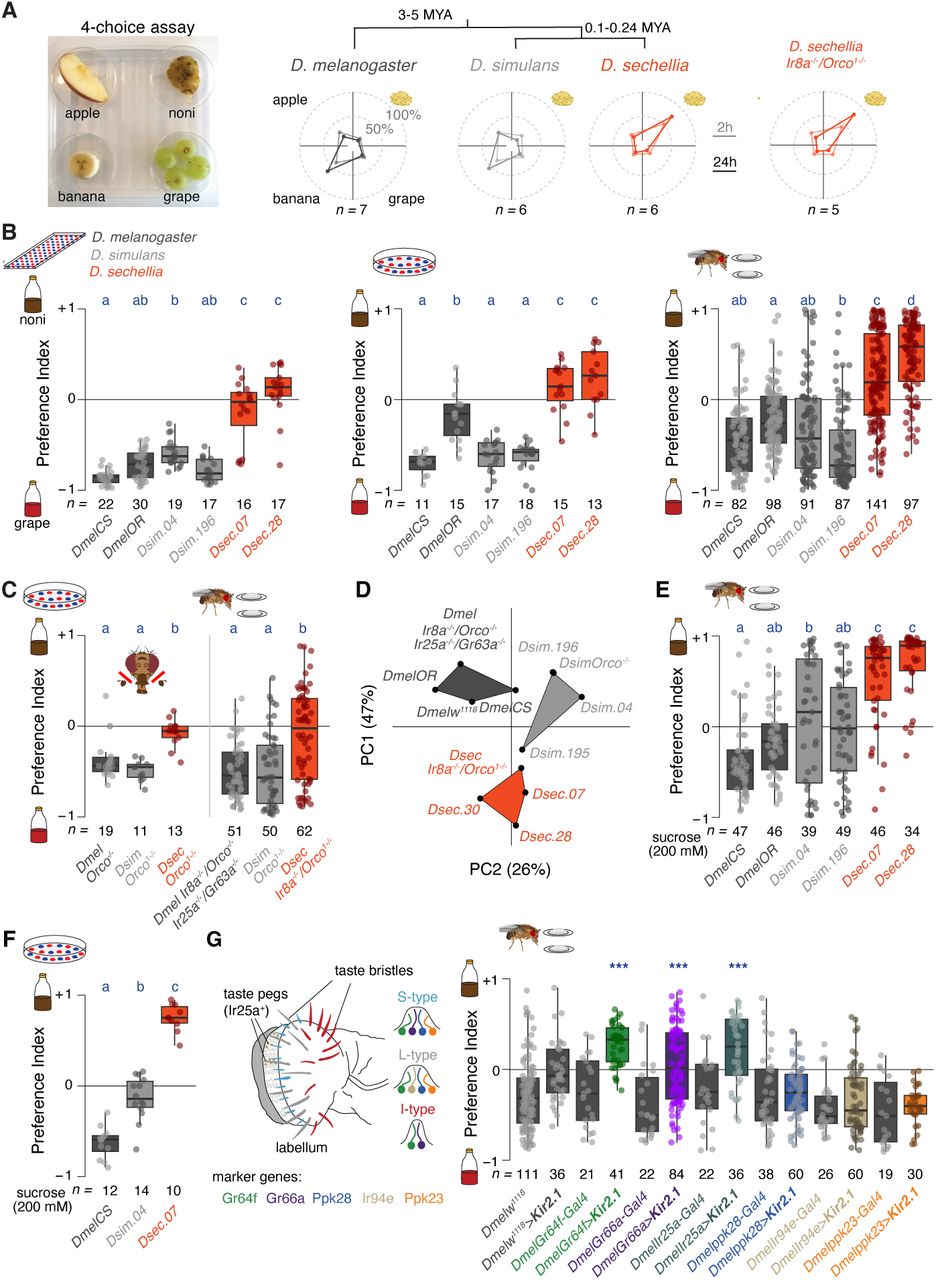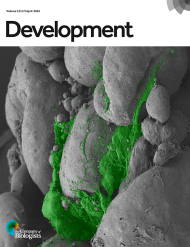Evolution of taste processing shifts dietary preference
Posted on: 31 March 2025
Preprint posted on 12 October 2024
Flies learning to like 'vomit fruit': an example of bitter going from 'yuck' to 'yum.' New research in Drosophila sechellia reveals how taste circuits can evolve to make bitter better. 🍋🪰
Selected by T. W. SchwanitzCategories: animal behavior and cognition, evolutionary biology, genomics, neuroscience
Introduction
Do you like dark chocolate? If so, you’re not alone in your penchant for bitter foods. One particular species of Drosophila has also evolved a taste for what would otherwise be a repulsive cue: Drosophila sechellia. Among the 1,600 or so species of Drosophila, this one stands out for its remarkable specialization—feeding and laying eggs primarily on noni fruit, which is native to the Seychelles. Often called “vomit fruit” due to its notably unpleasant smell (at least to humans), noni fruit is preferred by D. sechellia over more commonly appealing options like bananas, grapes, or apples (Fig. 1A). This raises an intriguing question: where did this peculiar preference come from, and what specific neural circuits might underlie it?
To investigate, Bertolini and colleagues harnessed the extensive genetic tools available for Drosophila melanogaster and conducted a series of behavioral experiments across three species of drosophilids—all to help unravel the evolutionary mechanisms behind bitter acceptance and noni specialization in D. sechellia.
Highlighted results
Even a cursory glance at the figures in this paper reveals that this is far from a straightforward story. With the growing arsenal of tools available to neuroscientists—especially those working with Drosophila—it has become increasingly apparent that biological neural circuits function in intricate and often seemingly paradoxical ways. Readers are encouraged to dig into the preprint for all the complexity of this story, as the scope of this preLight is limited to some of the especially interesting insights and experiments.
To begin, the authors demonstrate that the preference for noni is supported by changes in taste, even in the absence of olfactory input. Using a well-designed semi-natural four-choice assay with real fruit, they tested D. sechellia flies that were genetically modified to be unable to smell most compounds by knocking out two key olfactory co-receptor genes, Ir8a and Orco (Fig. 1A, rightmost plot). The authors then employed various preference assays, confirming that these effectively capture D. sechellia’s natural affinity for noni fruit under different conditions (Fig. 1B-E). One particularly compelling experiment involved D. sechellia flies with the Orco gene knocked out and their antennae surgically ablated, rendering them completely anosmic. While these flies did not exhibit a clear preference for noni juice over grape juice, they still showed a statistically significant difference in behavior compared to the generalist species Drosophila melanogaster and Drosophila simulans (Fig. 1C). This indicates that something has changed in the taste system of this species.

Figure 1 of the preprint: A) Illustrates the behavioral four-choice assay, highlighting the species’ preferences investigated in this study and showing that D. sechellia flies with limited olfactory capabilities still favor noni. B) shows several different types of assays the authors tested, all reproducing the loss of sweet preference. C) Flies with their antennae removed still choose noni over grape juice. D-F) More experiments and analysis showing that D. sechellia prefers noni (check out the preprint for all the details!). G) Schematic of different taste receptors on the fly’s labellum (its tongue, effectively). Sweet and bitter neurons when silenced (green, purple, i.e., those first two with asterisks over them; Ir25a, the final one with asterisks, is expressed in all taste neurons) change D. melanogaster’s preference for grape juice over noni juice.
To explore the genetic basis of these species differences, the authors leveraged the extensive genetic toolkit available in D. melanogaster, the six-legged workhorse of biology. They used several transgenic lines in D. melanogaster to drive the expression of Kir2.1 in neurons responsible for sensing bitter and sweet (Fig. 1G). Kir2.1 is an inward-rectifier potassium channel that hyperpolarizes neurons, effectively silencing them. Highlighting the intricacies of taste processing, they found that silencing neurons involved in sensing any of these modalities—sweet, bitter, or acidic—could alter D. melanogaster’s preference for noni juice (Fig. 1G, green, purple, and gray-blue boxplots).
Amid the complexity of taste processing, it is remarkable that the authors identified a specific receptor change that probably plays a role in D. sechellia’s preference for noni fruit. The gustatory receptor Gr39a, previously identified as a caffeine sensor in D. melanogaster, was shown to have four alternatively spliced isoforms. One isoform, Gr39a.a, carries a three-amino-acid deletion specifically in D. sechellia (Fig. 4B of the preprint). While this deletion does not occur in the ligand-binding domain, it nonetheless has a significant impact on the function of the bitter receptor Gr39a.a, as demonstrated in the authors’ experiments. When the D. sechellia version of Gr39a.a was expressed in D. melanogaster flies lacking their own endogenous protein, neurons stimulated by caffeine responded similarly to those in complete knockouts (Fig. 4D of the preprint). These results indicate that the D. sechellia variant of Gr39a.a behaves like a non-functional protein in this assay.
Bertolini and colleagues conducted additional experiments to further probe the role of Gr39a.a in shaping neuronal response dynamics to bitter compounds like caffeine and coumarin. They demonstrated that expressing the D. sechellia version of Gr39a.a in D. melanogaster alters the neuronal response dynamics of bitter neurons, making them resemble those of D. sechellia. Conversely, expressing the D. melanogaster version of Gr39a.a in D. sechellia produces neuronal dynamics similar to D. melanogaster’s bitter neurons. It seems straightforward, right? Swap the Gr39a.a allele between the two species and then their bitter neurons swap properties too.
However, the plot thickens with behavioral experiments. While D. sechellia bitter neurons can be activated by caffeine when they carry the D. melanogaster version of the allele (Fig. 4F), the flies themselves are not repulsed by the taste of caffeine in the same way that D. melanogaster flies are (Fig. 4G-H). This striking observation suggests that higher-level neural circuits process bitter tastes differently in D. sechellia, which relishes the bitter noni juice. In the preprint’s final main figure (Fig. 5), the authors delve into these higher-order circuits, proposing that differences in interneuron activity may help explain the distinct taste processing in D. sechellia.
Why I liked this preprint
This work tackles an intricate neural circuit through an evolutionarily informed lens. One of my favorite aspects of this preprint is the semi-natural four-choice assay: an elegantly designed experiment that uses a real, complex stimulus to convincingly demonstrate the predilections of different fly species. It also persuasively shows that taste plays a central role in D. sechellia’s preference for noni. I particularly appreciated the authors’ efforts to unravel both the peripheral changes in the bitter-tasting circuit and the alterations in higher-order processing areas of the brain, offering a comprehensive view of how these adaptations may contribute to D. sechellia’s unique behavior.
doi: https://doi.org/10.1242/prelights.40091
Read preprintSign up to customise the site to your preferences and to receive alerts
Register hereAlso in the animal behavior and cognition category:
Responses to conflicting binocular stimuli in mouse primary visual cortex
Maitri Manjunath
Effects of transcranial photobiomodulation on peripheral biomarkers associated with oxidative stress and complex IV activity in the prefrontal cortex in rats subjected to chronic mild stress
Rickson Ribeiro, Marcus Oliveira
Psychedelics Align Brain Activity with Context
Loïk Holdrinet et al.
Also in the evolutionary biology category:
A high-coverage genome from a 200,000-year-old Denisovan
AND
A global map for introgressed structural variation and selection in humans
Siddharth Singh
Dissecting Gene Regulatory Networks Governing Human Cortical Cell Fate
Manuel Lessi
Beyond venomous fangs: Uloboridae spiders have lost their venom but not their toxicity
Daniel Fernando Reyes Enríquez, Marcus Oliveira
Also in the genomics category:
Microbial Feast or Famine: dietary carbohydrate composition and gut microbiota metabolic function
Jasmine Talevi
A high-coverage genome from a 200,000-year-old Denisovan
AND
A global map for introgressed structural variation and selection in humans
Siddharth Singh
Human single-cell atlas analysis reveals heterogeneous endothelial signaling
Charis Qi
Also in the neuroscience category:
Imaging cellular activity simultaneously across all organs of a vertebrate reveals body-wide circuits
Muhammed Sinan Malik
Post-translational Tuning of Human Cortical Progenitor Neuronal Output
Jawdat Sandakly
Maturation of the glymphatic system confers innate resistance of the brain to Zika virus infection
Jimeng Li
preLists in the animal behavior and cognition category:
Biologists @ 100 conference preList
This preList aims to capture all preprints being discussed at the Biologists @100 conference in Liverpool, UK, either as part of the poster sessions or the (flash/short/full-length) talks.
| List by | Reinier Prosee, Jonathan Townson |
9th International Symposium on the Biology of Vertebrate Sex Determination
This preList contains preprints discussed during the 9th International Symposium on the Biology of Vertebrate Sex Determination. This conference was held in Kona, Hawaii from April 17th to 21st 2023.
| List by | Martin Estermann |
Bats
A list of preprints dealing with the ecology, evolution and behavior of bats
| List by | Baheerathan Murugavel |
FENS 2020
A collection of preprints presented during the virtual meeting of the Federation of European Neuroscience Societies (FENS) in 2020
| List by | Ana Dorrego-Rivas |
Also in the evolutionary biology category:
November in preprints – DevBio & Stem cell biology
preLighters with expertise across developmental and stem cell biology have nominated a few developmental and stem cell biology (and related) preprints posted in November they’re excited about and explain in a single paragraph why. Concise preprint highlights, prepared by the preLighter community – a quick way to spot upcoming trends, new methods and fresh ideas.
| List by | Aline Grata et al. |
October in preprints – DevBio & Stem cell biology
Each month, preLighters with expertise across developmental and stem cell biology nominate a few recent developmental and stem cell biology (and related) preprints they’re excited about and explain in a single paragraph why. Short, snappy picks from working scientists — a quick way to spot fresh ideas, bold methods and papers worth reading in full. These preprints can all be found in the October preprint list published on the Node.
| List by | Deevitha Balasubramanian et al. |
October in preprints – Cell biology edition
Different preLighters, with expertise across cell biology, have worked together to create this preprint reading list for researchers with an interest in cell biology. This month, most picks fall under (1) Cell organelles and organisation, followed by (2) Mechanosignaling and mechanotransduction, (3) Cell cycle and division and (4) Cell migration
| List by | Matthew Davies et al. |
Biologists @ 100 conference preList
This preList aims to capture all preprints being discussed at the Biologists @100 conference in Liverpool, UK, either as part of the poster sessions or the (flash/short/full-length) talks.
| List by | Reinier Prosee, Jonathan Townson |
‘In preprints’ from Development 2022-2023
A list of the preprints featured in Development's 'In preprints' articles between 2022-2023
| List by | Alex Eve, Katherine Brown |
preLights peer support – preprints of interest
This is a preprint repository to organise the preprints and preLights covered through the 'preLights peer support' initiative.
| List by | preLights peer support |
EMBO | EMBL Symposium: The organism and its environment
This preList contains preprints discussed during the 'EMBO | EMBL Symposium: The organism and its environment', organised at EMBL Heidelberg, Germany (May 2023).
| List by | Girish Kale |
9th International Symposium on the Biology of Vertebrate Sex Determination
This preList contains preprints discussed during the 9th International Symposium on the Biology of Vertebrate Sex Determination. This conference was held in Kona, Hawaii from April 17th to 21st 2023.
| List by | Martin Estermann |
EMBL Synthetic Morphogenesis: From Gene Circuits to Tissue Architecture (2021)
A list of preprints mentioned at the #EESmorphoG virtual meeting in 2021.
| List by | Alex Eve |
Planar Cell Polarity – PCP
This preList contains preprints about the latest findings on Planar Cell Polarity (PCP) in various model organisms at the molecular, cellular and tissue levels.
| List by | Ana Dorrego-Rivas |
TAGC 2020
Preprints recently presented at the virtual Allied Genetics Conference, April 22-26, 2020. #TAGC20
| List by | Maiko Kitaoka et al. |
ECFG15 – Fungal biology
Preprints presented at 15th European Conference on Fungal Genetics 17-20 February 2020 Rome
| List by | Hiral Shah |
COVID-19 / SARS-CoV-2 preprints
List of important preprints dealing with the ongoing coronavirus outbreak. See http://covidpreprints.com for additional resources and timeline, and https://connect.biorxiv.org/relate/content/181 for full list of bioRxiv and medRxiv preprints on this topic
| List by | Dey Lab, Zhang-He Goh |
1
SDB 78th Annual Meeting 2019
A curation of the preprints presented at the SDB meeting in Boston, July 26-30 2019. The preList will be updated throughout the duration of the meeting.
| List by | Alex Eve |
Pattern formation during development
The aim of this preList is to integrate results about the mechanisms that govern patterning during development, from genes implicated in the processes to theoritical models of pattern formation in nature.
| List by | Alexa Sadier |
Also in the genomics category:
November in preprints – DevBio & Stem cell biology
preLighters with expertise across developmental and stem cell biology have nominated a few developmental and stem cell biology (and related) preprints posted in November they’re excited about and explain in a single paragraph why. Concise preprint highlights, prepared by the preLighter community – a quick way to spot upcoming trends, new methods and fresh ideas.
| List by | Aline Grata et al. |
May in preprints – the CellBio edition
A group of preLighters, with expertise in different areas of cell biology, have worked together to create this preprint reading lists for researchers with an interest in cell biology. This month, categories include: 1) Biochemistry/metabolism 2) Cancer cell Biology 3) Cell adhesion, migration and cytoskeleton 4) Cell organelles and organisation 5) Cell signalling and 6) Genetics
| List by | Barbora Knotkova et al. |
March in preprints – the CellBio edition
A group of preLighters, with expertise in different areas of cell biology, have worked together to create this preprint reading lists for researchers with an interest in cell biology. This month, categories include: 1) cancer biology 2) cell migration 3) cell organelles and organisation 4) cell signalling and mechanosensing 5) genetics and genomics 6) other
| List by | Girish Kale et al. |
Biologists @ 100 conference preList
This preList aims to capture all preprints being discussed at the Biologists @100 conference in Liverpool, UK, either as part of the poster sessions or the (flash/short/full-length) talks.
| List by | Reinier Prosee, Jonathan Townson |
Early 2025 preprints – the genetics & genomics edition
In this community-driven preList, a group of preLighters, with expertise in different areas of genetics and genomics have worked together to create this preprint reading list. Categories include: 1) bioinformatics 2) epigenetics 3) gene regulation 4) genomics 5) transcriptomics
| List by | Chee Kiang Ewe et al. |
End-of-year preprints – the genetics & genomics edition
In this community-driven preList, a group of preLighters, with expertise in different areas of genetics and genomics have worked together to create this preprint reading list. Categories include: 1) genomics 2) bioinformatics 3) gene regulation 4) epigenetics
| List by | Chee Kiang Ewe et al. |
BSCB-Biochemical Society 2024 Cell Migration meeting
This preList features preprints that were discussed and presented during the BSCB-Biochemical Society 2024 Cell Migration meeting in Birmingham, UK in April 2024. Kindly put together by Sara Morais da Silva, Reviews Editor at Journal of Cell Science.
| List by | Reinier Prosee |
9th International Symposium on the Biology of Vertebrate Sex Determination
This preList contains preprints discussed during the 9th International Symposium on the Biology of Vertebrate Sex Determination. This conference was held in Kona, Hawaii from April 17th to 21st 2023.
| List by | Martin Estermann |
Semmelweis Symposium 2022: 40th anniversary of international medical education at Semmelweis University
This preList contains preprints discussed during the 'Semmelweis Symposium 2022' (7-9 November), organised around the 40th anniversary of international medical education at Semmelweis University covering a wide range of topics.
| List by | Nándor Lipták |
20th “Genetics Workshops in Hungary”, Szeged (25th, September)
In this annual conference, Hungarian geneticists, biochemists and biotechnologists presented their works. Link: http://group.szbk.u-szeged.hu/minikonf/archive/prg2021.pdf
| List by | Nándor Lipták |
EMBL Conference: From functional genomics to systems biology
Preprints presented at the virtual EMBL conference "from functional genomics and systems biology", 16-19 November 2020
| List by | Jesus Victorino |
TAGC 2020
Preprints recently presented at the virtual Allied Genetics Conference, April 22-26, 2020. #TAGC20
| List by | Maiko Kitaoka et al. |
Zebrafish immunology
A compilation of cutting-edge research that uses the zebrafish as a model system to elucidate novel immunological mechanisms in health and disease.
| List by | Shikha Nayar |
Also in the neuroscience category:
November in preprints – DevBio & Stem cell biology
preLighters with expertise across developmental and stem cell biology have nominated a few developmental and stem cell biology (and related) preprints posted in November they’re excited about and explain in a single paragraph why. Concise preprint highlights, prepared by the preLighter community – a quick way to spot upcoming trends, new methods and fresh ideas.
| List by | Aline Grata et al. |
October in preprints – DevBio & Stem cell biology
Each month, preLighters with expertise across developmental and stem cell biology nominate a few recent developmental and stem cell biology (and related) preprints they’re excited about and explain in a single paragraph why. Short, snappy picks from working scientists — a quick way to spot fresh ideas, bold methods and papers worth reading in full. These preprints can all be found in the October preprint list published on the Node.
| List by | Deevitha Balasubramanian et al. |
October in preprints – Cell biology edition
Different preLighters, with expertise across cell biology, have worked together to create this preprint reading list for researchers with an interest in cell biology. This month, most picks fall under (1) Cell organelles and organisation, followed by (2) Mechanosignaling and mechanotransduction, (3) Cell cycle and division and (4) Cell migration
| List by | Matthew Davies et al. |
July in preprints – the CellBio edition
A group of preLighters, with expertise in different areas of cell biology, have worked together to create this preprint reading lists for researchers with an interest in cell biology. This month, categories include: (1) Cell Signalling and Mechanosensing (2) Cell Cycle and Division (3) Cell Migration and Cytoskeleton (4) Cancer Biology (5) Cell Organelles and Organisation
| List by | Girish Kale et al. |
May in preprints – the CellBio edition
A group of preLighters, with expertise in different areas of cell biology, have worked together to create this preprint reading lists for researchers with an interest in cell biology. This month, categories include: 1) Biochemistry/metabolism 2) Cancer cell Biology 3) Cell adhesion, migration and cytoskeleton 4) Cell organelles and organisation 5) Cell signalling and 6) Genetics
| List by | Barbora Knotkova et al. |
April in preprints – the CellBio edition
A group of preLighters, with expertise in different areas of cell biology, have worked together to create this preprint reading lists for researchers with an interest in cell biology. This month, categories include: 1) biochemistry/metabolism 2) cell cycle and division 3) cell organelles and organisation 4) cell signalling and mechanosensing 5) (epi)genetics
| List by | Vibha SINGH et al. |
Biologists @ 100 conference preList
This preList aims to capture all preprints being discussed at the Biologists @100 conference in Liverpool, UK, either as part of the poster sessions or the (flash/short/full-length) talks.
| List by | Reinier Prosee, Jonathan Townson |
2024 Hypothalamus GRC
This 2024 Hypothalamus GRC (Gordon Research Conference) preList offers an overview of cutting-edge research focused on the hypothalamus, a critical brain region involved in regulating homeostasis, behavior, and neuroendocrine functions. The studies included cover a range of topics, including neural circuits, molecular mechanisms, and the role of the hypothalamus in health and disease. This collection highlights some of the latest advances in understanding hypothalamic function, with potential implications for treating disorders such as obesity, stress, and metabolic diseases.
| List by | Nathalie Krauth |
‘In preprints’ from Development 2022-2023
A list of the preprints featured in Development's 'In preprints' articles between 2022-2023
| List by | Alex Eve, Katherine Brown |
CSHL 87th Symposium: Stem Cells
Preprints mentioned by speakers at the #CSHLsymp23
| List by | Alex Eve |
Journal of Cell Science meeting ‘Imaging Cell Dynamics’
This preList highlights the preprints discussed at the JCS meeting 'Imaging Cell Dynamics'. The meeting was held from 14 - 17 May 2023 in Lisbon, Portugal and was organised by Erika Holzbaur, Jennifer Lippincott-Schwartz, Rob Parton and Michael Way.
| List by | Helen Zenner |
FENS 2020
A collection of preprints presented during the virtual meeting of the Federation of European Neuroscience Societies (FENS) in 2020
| List by | Ana Dorrego-Rivas |
ASCB EMBO Annual Meeting 2019
A collection of preprints presented at the 2019 ASCB EMBO Meeting in Washington, DC (December 7-11)
| List by | Madhuja Samaddar et al. |
SDB 78th Annual Meeting 2019
A curation of the preprints presented at the SDB meeting in Boston, July 26-30 2019. The preList will be updated throughout the duration of the meeting.
| List by | Alex Eve |
Autophagy
Preprints on autophagy and lysosomal degradation and its role in neurodegeneration and disease. Includes molecular mechanisms, upstream signalling and regulation as well as studies on pharmaceutical interventions to upregulate the process.
| List by | Sandra Malmgren Hill |
Young Embryologist Network Conference 2019
Preprints presented at the Young Embryologist Network 2019 conference, 13 May, The Francis Crick Institute, London
| List by | Alex Eve |











 (No Ratings Yet)
(No Ratings Yet)